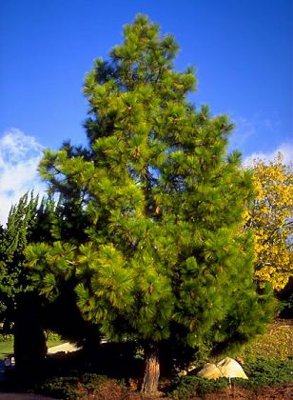Canary Island Pine (Pinus canariensis)
Category: Evergreen Trees

Originating from off the coast of Canary Islands in Northwest Africa, the Canary Island Pine tree is one of the most graceful trees out there as if is characterized by long needles that droop elegantly though it doesn’t feature weeping branches. The most outstanding characteristic of this tree is the blue-green shoots that germinate from below the trunk. These shoots are usually referred to as epicorpic shoots and they develop as a system to combat fire, injury and other damages that may happen to the tree trunk. Propagated through the seeds, it takes this tree about two and a 1/2 years to reach maturity. They are widely planted in Southern Spain as ornamental trees.
Attributes
They feature 3 needles per fascicle. These needles are in fact, some of the longest pine needles that can be found among the trees of the same species and can be 12 inches or even longer.The Canary Island tree has 3 needles per fascicle and they are longest needles found among the various the pine species and can be as long as 12†or even longer. Being a monoecious tree, the male and female flowers (strobili) appear on the Canary Islands pine tree. They produce brown and large cones measuring about 6†in length. The tree grows at a rate of about 36" per season.
Conditions For Growth
This pine does well in full sunny conditions. They are hardy and can grow well in climate zone 9 all the way through to zone 11. They also grow optimally in loamy, acidic, moist, sandy and well-drained soils. The tree doesn’t tolerate drought conditions but it may need irrigation with neutral water or neutral water or it to grow in desert-like conditions. The flowers that blossom in yellow in the spring produces 6’’ oval brown cones.
Shape, Leaves And Size
The Canary Islands pine tree species grows generally anywhere from a height of 50’ to 80’ and with a width of about 28 to 32 inches. Sometimes they may reach up to 100’ tall. While it is young, this tree exhibits a pyramid-like shape that can change as the tree ages. As it matures, it can spread to about half as wide as its height.

 Back To Category Evergreen Trees
Back To Category Evergreen Trees